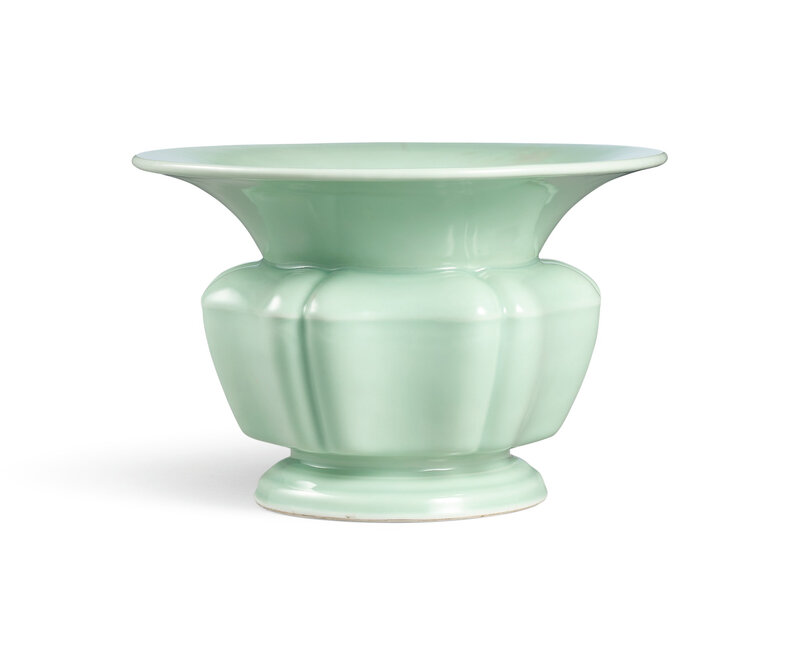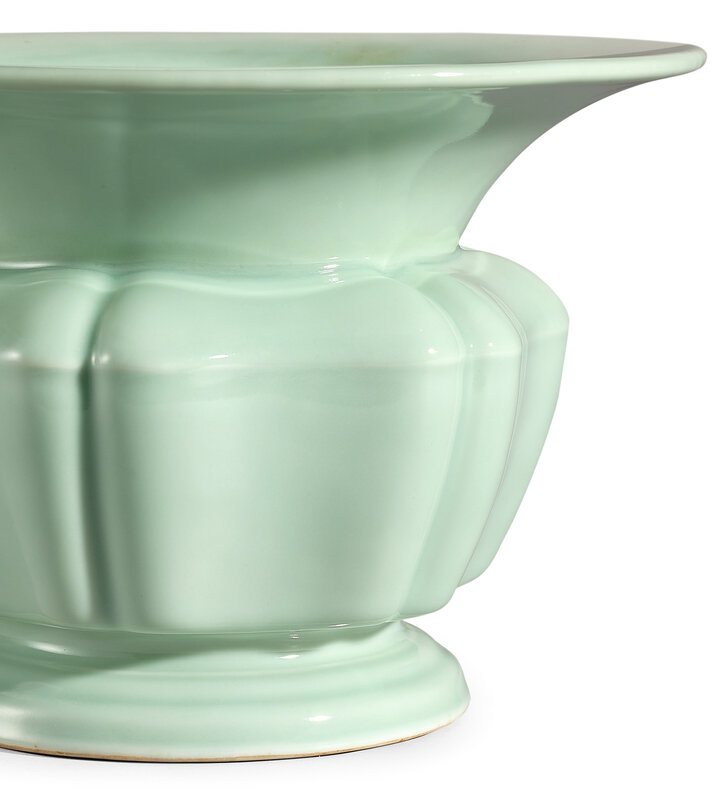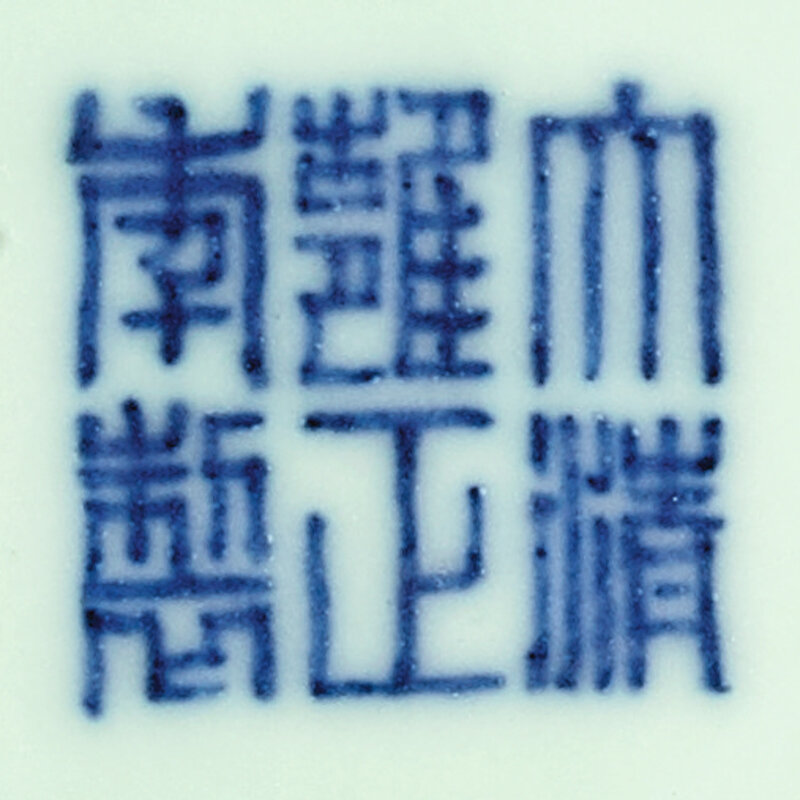A fine celadon-glazed lobed zhadou, Seal mark and period of Yongzheng (1723-1735)
Lot 116. A fine celadon-glazed lobed zhadou, Seal mark and period of Yongzheng (1723-1735); 20.9 cm, 8 1/4 in.. Estimate 1,500,000 — 2,000,000 HKD (190,995 - 254,660 USD). Lot sold 5,215,000 HKD (664,026 USD). Courtesy Sotheby's.
the shouldered body divided into six undulating lobes resembling petals, all supported on a stepped splayed foot and surmounted by a short trumpet-shaped mouth, covered overall save for the footring with an even bluish-green glaze, the base inscribed in underglaze blue with a six-character seal mark.
Provenance: Collection of T.Y. Chao (1912-1999).
Sotheby's Hong Kong, 19th May 1987, lot 285.
Note: This vase exemplifies the technical perfection obtained by craftsmen working during the Yongzheng period through its deceptively simple form and luminous celadon glaze. The Yongzheng Emperor was a keen antiquarian who instructed the study and production of numerous pieces from the Imperial collections. As with many monochrome wares produced during his reign, both the form and glaze reference celebrated traditions from China's illustrious cultural history. The form is a reinterpretation of the archaic bronze zun, while the subtle glaze has been created in imitation of Longquan celadon of the Song period (960-1279). Monochrome vessels required great skill in every stage of their production, from the purity of the clay and precision of potting to the evenness of the glaze and control of the firing process.
A closely related example from the Baur collection is illustrated in Gakuji Hasebe and Fujio Nakazawa eds, Chūgoku no tōji. Shin no kanyō [Chinese ceramics. Official wares in Qing dynasty], vol. 11, Tokyo, 1996, pl. 50; another in the Jingdezhen Ceramic Museum is illustrated in The Complete Collection of Porcelain of Jiangxi Province, Beijing, 2008, vol. II, pl. 69; and a further example was included in the exhibition Chinese Celadons and Other Related Wares in Southeast Asia, National Museum of Singapore, 1979, cat. no. 274. See also a zhadou of this type, from the J.M. Hu Family collection, sold in our New York rooms, 23rd September 1995, lot 427; and another sold in our London rooms, 3rd December 1974, lot 356, and again, 13th May 2009, lot 220.
Zhadou of this form appear to have been favoured by the Yongzheng Emperor and were also created with various glazes; for example, one of comparable size, but with a Ru-type glaze, in the National Palace Museum, Taipei is illustrated in A Panorama of Ceramics in the National Palace Museum: Chun ware, Taipei, 1999, pl. 15; one covered in a guan-type glaze, from the collection of Sir Herbert Ingram, now in the Ashmolean Museum, Oxford, is illustrated in Soame Jenyns, Later Chinese Porcelain. The Ch'ing Dynasty (1644-1912), London, 1951, pl. LXVI, fig. 2; and two turquoise-glazed examples were sold at Christie's London, 10th April, 1984, lot 227. Two zhadou are also depicted in the 1728 handscroll, Guwantu [Pictures of Antiquities], from the Sir Percival David collection, now in the British Museum, London, and included in the exhibition China. The Three Emperors. 1662-1795, Royal Academy of Arts, London, 2005, cat. no. 168.
Sotheby's. Important Chinese Art from the Collection of Sir Quo-Wei Lee II, Hong Kong, 08 October 2019

/https%3A%2F%2Fprofilepics.canalblog.com%2Fprofilepics%2F1%2F0%2F100183.jpg)
/https%3A%2F%2Fstorage.canalblog.com%2F03%2F02%2F119589%2F96711876_o.jpg)
/https%3A%2F%2Fstorage.canalblog.com%2F11%2F31%2F119589%2F94773502_o.jpg)
/https%3A%2F%2Fstorage.canalblog.com%2F20%2F83%2F119589%2F94772815_o.jpg)
/https%3A%2F%2Fstorage.canalblog.com%2F26%2F72%2F119589%2F75604929_o.jpg)
/https%3A%2F%2Fstorage.canalblog.com%2F59%2F60%2F119589%2F26458628_o.jpg)





/http%3A%2F%2Fstorage.canalblog.com%2F82%2F76%2F119589%2F127646905_o.jpg)
/http%3A%2F%2Fstorage.canalblog.com%2F15%2F02%2F119589%2F127059427_o.jpg)
/http%3A%2F%2Fstorage.canalblog.com%2F93%2F10%2F119589%2F127002705_o.jpg)
/http%3A%2F%2Fstorage.canalblog.com%2F86%2F30%2F119589%2F126061038_o.jpg)